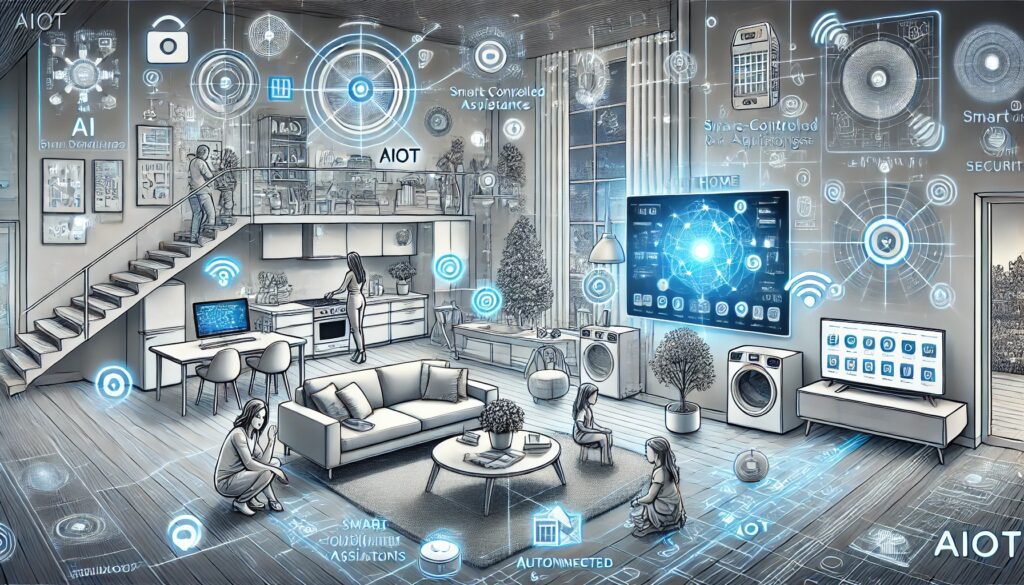
Discover the future of connectivity where AI meets IoT to create smarter, more efficient industries.
The Artificial Intelligence of Things (AIoT) represents the integration of Artificial Intelligence (AI) technologies with the Internet of Things (IoT) infrastructure. This convergence is driving significant advancements across multiple industries by combining the data generation and connectivity of IoT devices with the analytical and decision-making capabilities of AI.
Key Benefits and Applications of AIoT
Improved Operational Efficiency
AIoT enhances operational efficiency by enabling machines to generate, analyze data, and recognize patterns through machine learning. This results in faster problem detection, reduced manual processes, and optimized resource usage, significantly lowering operational costs. For example, in manufacturing, AIoT systems can predict when a machine part might fail, allowing for timely maintenance and preventing costly downtimes.
Real-Time Monitoring
Real-time monitoring and anomaly detection are crucial for preventing business interruptions. For instance, in the oil and gas industry, AIoT systems use remote cameras to detect leaks, saving both time and costs associated with manual inspections. In healthcare, real-time monitoring through AIoT devices can track patients’ vital signs and alert medical staff to any irregularities, potentially saving lives.
Enhanced Risk Management
AIoT systems excel in predicting and mitigating risks by analyzing data on potential threats. This is particularly beneficial in sectors like insurance, where AIoT helps manage risks related to machinery and factory operations. By foreseeing possible issues, companies can take proactive measures to avoid significant disruptions. In the financial sector, AIoT can detect fraudulent activities by analyzing transaction patterns and flagging anomalies.
Smart Industries
In manufacturing, AIoT is pivotal for predictive maintenance and quality control. Sensors and cameras continuously monitor machinery conditions, detecting defective parts before they cause major problems. This not only prevents expensive downtimes but also ensures that the products meet quality standards, thus enhancing overall efficiency and reliability. For instance, automotive manufacturers use AIoT to monitor the quality of components during production, ensuring that every vehicle meets safety standards.
Smart Cities and Homes
AIoT applications extend to smart cities, improving traffic management and public safety. In smart homes, AIoT enhances energy efficiency and automates household tasks by learning the homeowner’s habits. This leads to more sustainable living environments and convenience for residents, showcasing the potential of AIoT in everyday life. Smart thermostats, for example, learn users’ schedules and adjust temperatures accordingly, saving energy and reducing costs.
Combining AI and IoT creates a powerful synergy where data from connected devices is analyzed and acted upon instantly, driving efficiency and innovation.
— Satya Nadella, CEO of Microsoft
Market Growth and Trends
The global AIoT market is experiencing exponential growth. From $7.52 billion in 2023, it is expected to reach $9.98 billion in 2024, with a compound annual growth rate (CAGR) of 32.7%. By 2028, the market is forecasted to skyrocket to $31.05 billion. Key drivers of this growth include advancements in AI, the proliferation of IoT devices, the expansion of 5G networks, and the increased adoption of edge computing.
Advancements in AI: AI technologies are becoming more sophisticated, enabling better data analysis and decision-making capabilities.
Proliferation of IoT Devices: The number of connected devices is increasing rapidly, providing more data for AI to analyze.
Expansion of 5G Networks: 5G offers faster data transmission speeds, enabling real-time data processing and enhanced connectivity.
Increased Adoption of Edge Computing: Edge computing allows data processing closer to where it is generated, reducing latency and improving response times.
AIoT is the next big wave in technology, offering unprecedented opportunities for automation, efficiency, and data-driven decision-making
— Kevin Ashton, Inventor of the term “Internet of Things
Challenges and Future Outlook
Despite its numerous benefits, AIoT faces challenges, particularly regarding data privacy and security. The integration of AI and IoT involves managing vast amounts of sensitive data, making it a target for cyberattacks. Addressing these security concerns is crucial for the continued adoption and success of AIoT technologies.
Data Privacy: Ensuring that data collected by IoT devices is used ethically and stored securely is paramount.
Security Concerns: Protecting AIoT systems from cyberattacks requires robust security measures and constant vigilance.
Regulatory Compliance: Navigating different regulatory environments across the globe can be challenging for AIoT deployments.
The future of AIoT looks promising, with continuous advancements expected in cloud computing, edge AI, and the integration of generative AI. These technologies will further enhance the efficiency, security, and scalability of AIoT solutions, solidifying their role as a transformative force across industries.
Conclusion
The integration of AI and IoT is revolutionizing industries by making operations smarter, more efficient, and highly connected. From manufacturing to smart cities, the applications of AIoT are vast and varied, promising a future where technology seamlessly enhances every aspect of our lives.
By leveraging the power of AIoT, industries can look forward to a future of unparalleled efficiency and innovation.
FAQ
How does AIoT improve operational efficiency?
AIoT improves operational efficiency by enabling machines to generate and analyze data, recognize patterns, and make decisions through machine learning. This leads to faster problem detection, reduced manual processes, optimized resource usage, and lower operational costs.
What are some real-world applications of AIoT?
- Manufacturing: Predictive maintenance and quality control.
- Oil and Gas: Leak detection using remote cameras.
- Healthcare: Real-time patient monitoring.
- Smart Cities: Traffic management and public safety.
- Smart Homes: Energy efficiency and home automation.
How does AIoT enhance risk management?
AIoT enhances risk management by analyzing data to predict and mitigate potential threats. In industries like insurance and finance, AIoT systems can detect anomalies, assess risks, and suggest preventive measures, thereby reducing the likelihood of significant disruptions.
What is the current market growth for AIoT?
The global AIoT market is growing rapidly. In 2023, it was valued at $7.52 billion and is expected to reach $9.98 billion in 2024, with a CAGR of 32.7%. By 2028, the market is projected to reach $31.05 billion. This growth is driven by advancements in AI, the proliferation of IoT devices, 5G network expansion, and the adoption of edge computing.
What are the main challenges faced by AIoT?
- Data Privacy: Ensuring the ethical use and secure storage of data.
- Security Concerns: Protecting systems from cyberattacks.
- Regulatory Compliance: Navigating global regulatory environments.
What advancements are expected?
Future advancements in AIoT include developments in cloud computing, edge AI, and the integration of generative AI. These technologies will further enhance the efficiency, security, and scalability of AIoT solutions.
How does AIoT benefit smart homes?
In smart homes, AIoT improves energy efficiency and automates household tasks. Devices like smart thermostats learn homeowners’ schedules and adjust settings accordingly, leading to energy savings and increased convenience.
What role does AIoT play in smart cities?
In smart cities, AIoT applications include traffic management, public safety enhancements, and efficient resource utilization. By analyzing data from various sources, AIoT systems help create more livable and sustainable urban environments.
What industries are most impacted by AIoT?
AIoT impacts a wide range of industries including:
- Manufacturing
- Oil and Gas
- Healthcare
- Insurance
- Finance
- Transportation
- Retail
How can companies ensure data security in AIoT systems?
To ensure data security, companies should implement robust security measures such as:
- Encryption: Protecting data in transit and at rest.
- Regular Updates: Keeping software and firmware up-to-date.
- Access Controls: Restricting access to sensitive data.
- Continuous Monitoring: Detecting and responding to threats in real-time.
What is edge computing, and how does it relate to AIoT?
Edge computing involves processing data closer to where it is generated, rather than relying on centralized cloud servers. In AIoT, edge computing reduces latency and improves response times by enabling real-time data processing at the edge of the network.
Where can I learn more about AIoT?
For more detailed insights on AIoT, check out the following sources:
- Viso.ai
- Research and Markets
- Visual Capitalist
- Telenor IoT
These resources provide comprehensive information on the latest trends, market growth, and technological advancements in the AIoT field.





